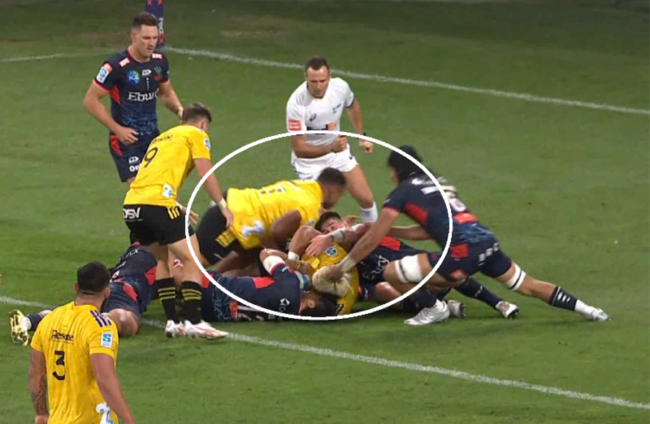LAST WEEKEND IN Melbourne, we saw the first-ever ‘upgraded’ red card in rugby.
Super Rugby Pacific is using a new system whereby referees can yellow card a player for foul play and the Television Match Official [TMO] then reviews the incident to decide whether the sanction should be upgraded to red. The TMO has eight minutes in which to make their decision.
It’s worth noting that Super Rugby is still using the 20-minute red card, which means that the player who is shown red can be replaced by another player once their 20-minute punishment ends.
That said, Super Rugby referees can now issue a full, permanent red card for clearly deliberate acts of foul play like punching someone in the face. In that case, the red-carded player can’t be replaced after 20 minutes.
Let’s take a look at how the upgraded red card worked in practice.
It’s the 44th minute of the Hurricanes’ win over the Melbourne Rebels when the visiting team are held up over the tryline. Rebels number eight Richard Hardwick takes a blow to the head and stays down.
Referee James Doleman asks for time off as Hardwick receives medical attention and he’s notified by the TMO, Oli Kellet, that they need to check the contact on the Rebels player.
Doleman calls for the TMO review and we get a close-up shot of Hurricanes prop Tevita Mafileo making direct contact with the head of Hardwick.
“We have clear head contact there,” says Doleman. “OK, so it clearly reaches yellow card threshold then.”
“Correct,” replies his TMO.
“Back to me, mate,” says Doleman as he calls an end to this on-field review of the incident, which has lasted less than 30 seconds and involved only two replays.
This is exactly what SANZAAR want from their new system – to avoid extended, interminable TMO reviews taking place out on the pitch while everyone waits for a decision.
Doleman confirms which Hurricanes player it was and shows Mafileo the yellow card.
“Yellow card, head contact… report, review,” says Doleman to confirm that the incident will now be reviewed by the TMO.
The TMO has eight minutes [on the match clock] in which to decide whether Mafileo’s foul play should be upgraded to red. World Rugby has said that there will be an additional TMO resource for all Super Rugby games, so one person can track the live action while the other reviews the yellow card.
So it is that seven minutes later, Doleman gets a heads up from his TMO and puts time off so he can explain what has happened in the background in the meantime.
Doleman calls Hurricanes captain Ardie Savea over and explains that Mafileo’s yellow has been upgraded to red.
“The off-field review for the high contact has been upgraded to a red because the player has come in with a tucked arm and has made direct contact, so it’s upgraded,” says Doleman.
“Is he off for good?” asks Savea.
“It’s upgraded to that 20-minute red card,” answers Doleman, who then brandishes his red card to Mafileo, who is still sitting on the sideline.
Mafileo appears to be confused, seemingly asking, “Am I off?”
Having only come off the bench at half time of this game, Mafileo’s day is indeed done after just three minutes of action on the pitch.
20 minutes after Mafileo was initially yellow-carded, the Hurricanes are able to replace him with Xavier Numia, who has started the game at loosehead prop, restoring them to 15 players.
As is now the norm in Super Rugby, Mafileo’s red card meant his foul play was considered by a SANZAAR Foul Play Review Committee in the days following the game.
This first step gives players the option of speeding up the judicial process by pleading guilty and accepting the penalty offered by the committee. If a player does not plead guilty, the case is referred on to a second SANZAAR Judicial Committee Hearing.
However, Mafileo pleaded guilty and accepted a three-week suspension – down from six weeks for his clean record and guilty plea – from the foul play review committee, which included former Munster player John Langford.
Due to this being Mafileo’s first offence, he was eligible for World Rugby’s ‘coaching intervention,’ which means he could have another week taken off his ban.
There have been a couple of other off-field reviews of yellow cards in the opening two rounds of Super Rugby Pacific but in those cases, the TMO has stuck with the yellow card issued by the referee on the pitch.
Fijian Drua prop Jone Tiko was shown yellow for this no-arms chop tackle last weekend and it was not upgraded upon review, with Tiko returning 10 minutes later.
In round one, Crusaders back row Ethan Blackadder was shown yellow for this high tackle against the Chiefs.
Referee Ben O’Keeffe used the signal below as he called for the off-field review.
Four minutes later, O’Keeffe informs the Crusaders that the yellow card was not being upgraded.
“It has been reviewed and there’s mitigation,” said O’Keeffe to Crusaders captain Scott Barrett.
On TV commentary, Justin Marshall told the audience, “The TMO decided, in his words, that there were mitigating factors, that the player was dipping and so it only warranted a yellow card.”
Whether one agrees with this decision or not, the process in these three instances has definitely involved a much quicker on-field review than might have been the case. In that sense, Super Rugby Pacific will feel it is already helping to speed the game up.
Clear and precise communication of the decisions will be important, with the ability to project the referee’s voice over the stadium tannoy in some Super Rugby venues key in allowing fans at the games to understand exactly what’s happening.
One other concern is the fact that referees may now simply hand the decision-making responsibility for red cards to their TMOs, rather than making that call on the pitch. TMOs were first brought in to assist referees in their decision-making but this system clearly involves more than that. Speeding the game up is important but World Rugby’s own law book states that the referee is “the sole judge of fact and of law during a match.”





















Was a great prospect from a young age and future clare 3 or 6
Seems like a great young lad. Willing to learn and capable. Giving credit to people. Humility with drive and determination, love the sound of him. Good luck to him.